

| Eilema Footman moths in Nottinghamshire |
| .............. |
| The Eilema group of
Footman moths are a common sight in (or at) the moth trap
run during the Summer months and along with large numbers
of Grass Veneers, can often form the bulk of the night's
catch. Despite it's name, the Scarce Footman is now easily the commonest of the group in our experience and has increased within the past five or so years. But this may not apply to Footmen moths attracted to MV lights run in the garden. To those with a new interest in moths and moth trapping, these can be a troublesome group of moths to get to grips with. The wing shape and size of all the Eilema Footmen likely to be encountered in Nottinghamshire, are all much the same, but there will occasionally be smaller examples of all species from time to time. In 2011, many adults we trapped were slightly smaller, possibly due to the dry Spring and Summer of that year. |
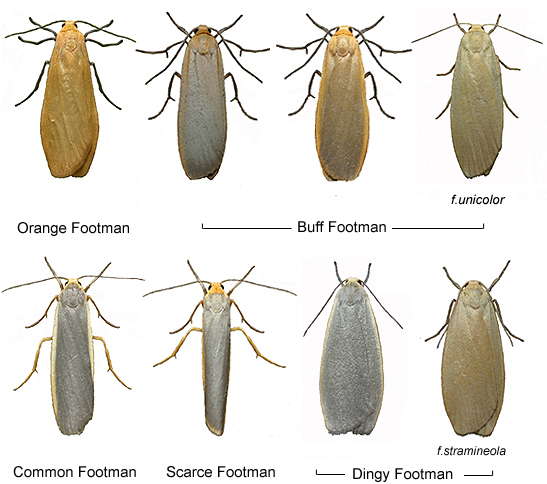 |
| ............... | ||||
| Known
Nottinghamshire species Nottinghamshire has five Eilema species to consider. These are Orange Footman Eilema sororcula, Dingy Footman Eilema griseola, Scarce Footman Eilema complana, Buff Footman Eilema depressa and Common Footman Eilema lurideola. Possible confusion species amongst other Footman moths in the county is very unlikely, but we list the following two species just in case. |
| ............... | ||
| Four-dotted
Footman Cybosia mesomella, is
widespread, but local in much of the southern UK and
Wales, with a range that extends into Scotland and the
moth is missing from much of the Midlands. There are no
post-1990 Nottinghamshire records, so this species is
probably never going to cause any potential
identification problems. It may still be possible (although considered unlikely) that it may turn up in the Sherwood Forest area once more. Hoary Footman Eilema caniola certainly would be a surprise in any Nottinghamshire moth trap, as this moth is largely confined to south-west coastal areas of the UK and Wales. Above right:- Larva of Orange Footman, found on lichen covered branches of Sallow at Nettleworth Manor, late July 2012. Below right:- Scarce Footman larva photographed at Sherwood Forest Country Park, late May 2006. |
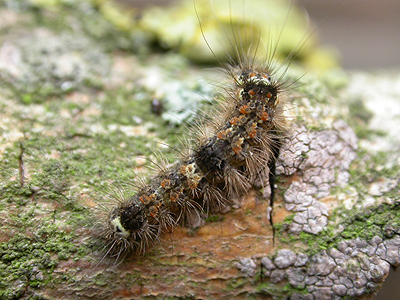 |
|
| ............... | ||
| Recent changes in
county records and status Of the five regularly occurring Nottinghamshire Footman moths, Common Footman has been the only species recorded in numbers throughout and is not included in the table below through lack of available data. However, the other four species, have all shown some increase in the number of records and sites sent in to the county recorder since 2003. The species showing the greatest increase in number of reported sites is Dingy Footman, whilst Scarce Footman has probably shown the greatest actual increase in population of all four since 2003. Dingy Footman still seems to be on the increase in Nottinghamshire, turning up at Eakring for the first time in 2008 and immediately becoming so regular that we thought maybe we had overlooked it among the numbers of Common Footman trapped. |
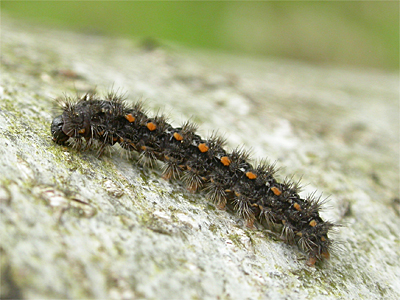 |
|
| ............... | ||
| Of course we hadn't, but it still sometimes seems strange that in these days of adverse publicity regarding the ever decreasing numbers of our butterflies and moths, that some species are actually doing quite well. Buff Footman has fared in similar fashion to Dingy Footman, showing a large increase since 2008, where Dingy Footman numbers really increased a year later, from 2009. | ||
| ............... | ||
|
The table shows the
changes in the reported number of sites of four Eilema
species between 2003 and 2013. The figures below each
year represent the number of sites where each species was
recorded. Data source:- Nottinghamshire Macro Moth Reports, 2003 and 2013, Sheila Wright |
| ............... | ||
| The changes
in status for these moths may be down to our warmer
climate, but it may be considered more likely to be
attributable to the increase in lichen growth on which
the larvae feed. Lower pollution levels have seen lichens
prosper. At Sherwood Forest in particular, over 30 years
ago, the trees were largely devoid of lichen and algal
growth, but now virtually all the mature trees have at
least some lichen growth and Footman larvae can often be
found grazing the trunks and branches, fence posts and
lichens growing on the forest floor in the more open
areas. Visual identification and determination All five Eilema Footman moths that occur in Nottinghamshire are shown here, for easy comparison. |
||
| ............... |
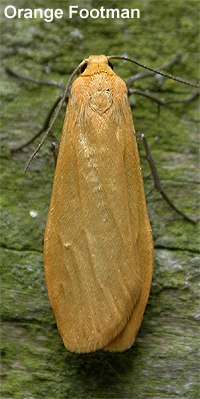 |
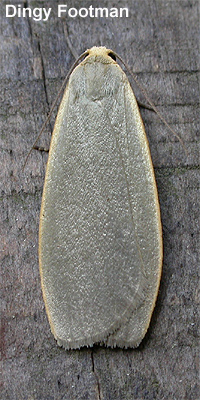 |
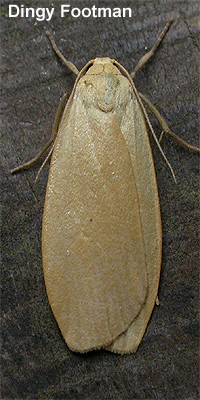 |
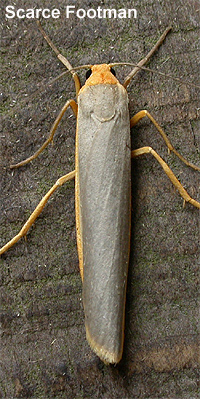 |
||
| ....... | |||||
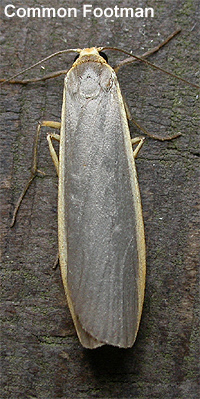 |
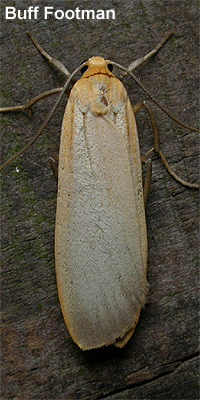 |
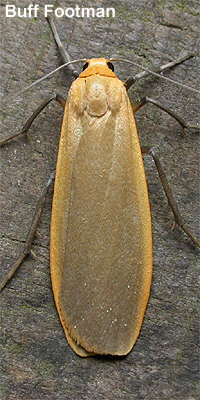 |
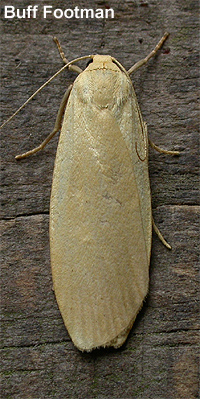 |
||
| ............... | ||
| The
difficulties in Footman identification experienced by
those new to moth trapping, are not helped by both Dingy
Footman and Buff Footman having yellow colour forms.
Determination of Orange Footman is made easier by having
an earlier flight period than other species. We have
records of Orange Footman from between May 2nd and June
20th, but the flight periods of most species are
generally given as July to August. From experience this is slightly inaccurate, as we have recorded Common Footman from mid-May and Scarce Footman from mid-June onwards. We even have a record of a very fresh Buff Footman from 24th October 2006. |
||
| ............... |
| 72.043 .... B&F 2049 .... Buff Footman Eilema depressa (Esper,
1787) |
||
| Nottinghamshire
status and distribution: Still listed as Grade 3
in Nottinghamshire, yet this is a widespread moth across
the whole of the county. Generally found in both
deciduous and mixed woodland. Flight period: There are records from October, but the main flight period is July to August. Identification features: Buff Footman can show three distinct colour forms and all three are shown together in the comparison photographs above. In general, the outer edge of the forewing of Buff Footman is very slightly broader and only gradually rounded towards the wing tip. The yellow streak running along the outer edge of the forewing, is less distinct in Buff Footman than in the other species. The pale yellow form (f.unicolor), does have slightly broader and rounded wings than the normal form of Buff Footman, but the curvature is not to the extent of that of Dingy Footman. |
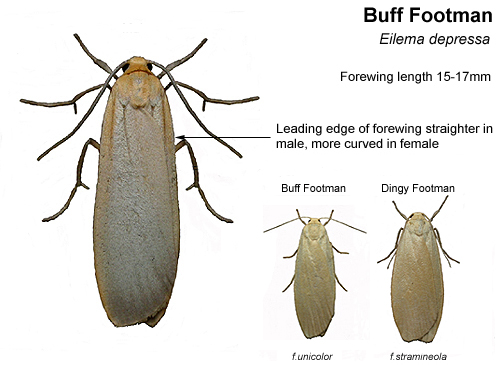 |
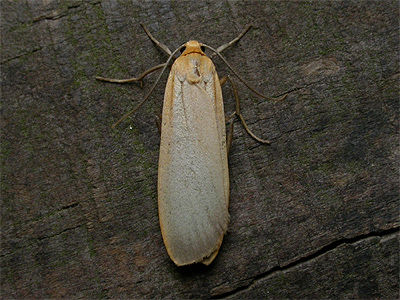 |
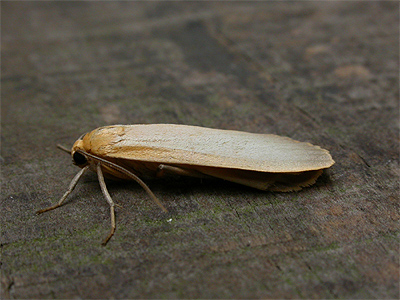 |
|
| ............... | ||
| Eilema depressa f. unicolor | ||
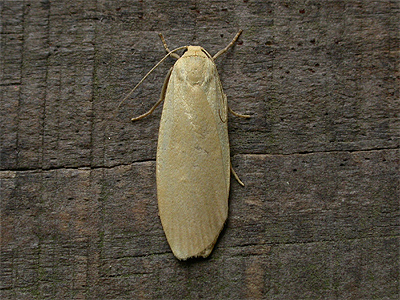 |
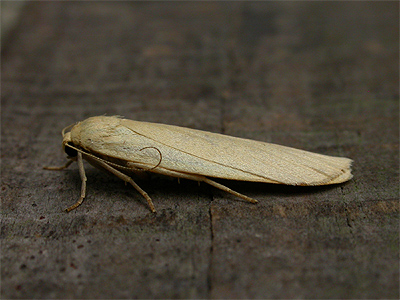 |
|
| 72.044 .... B&F 2044 .... Dingy Footman Eilema griseola (Hübner,
1803) |
| Nottinghamshire
status and distribution: Common and widespread
across Nottinghamshire, showing an increase in recent
years. Found in woodland, but also in most habitat types
including gardens. Regularly found resting by day, openly
on the leaves of trees and shrubs. Flight period: Mainly July to August, with a few adults remaining into September. Identification features: Dingy Footman has very broad wings in comparison to the other species and once seen, this moth is easily recognised. The grey form of this moth, has a thin yellow stripe, running along the leading edge of the forewing. As with Buff Footman, there is a pale yellow form of Dingy Footman (f.stramineola) which could be confused with the pale yellow form of Buff Footman (f. unicolor). But the leading edge of the forewings on Dingy Footman, are broader and much more curved towards the wing tip |
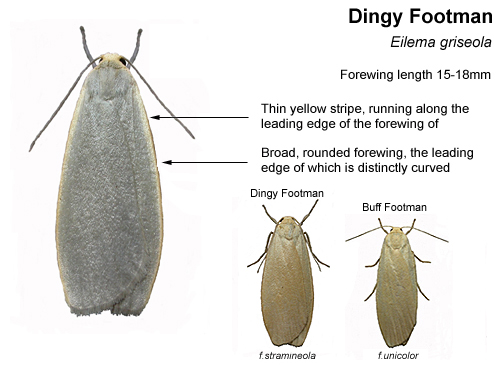 |
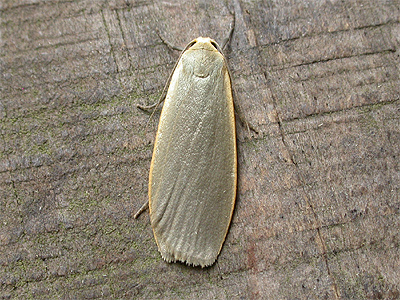 |
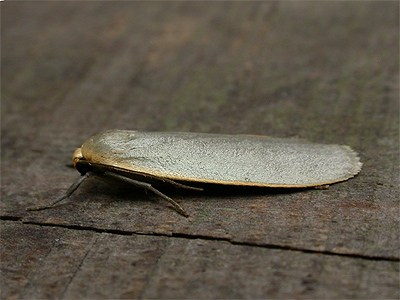 |
|
| .... | ||
| Eilema griseola f. stramineola | ||
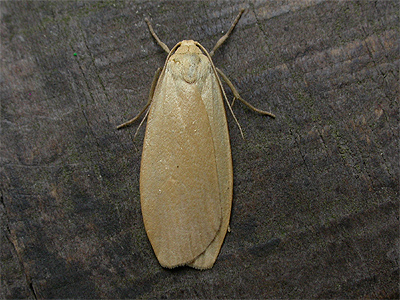 |
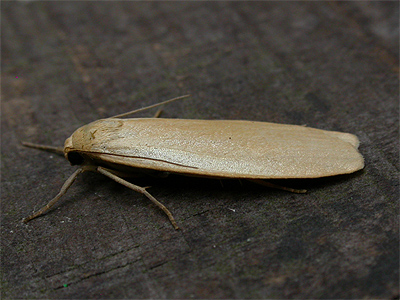 |
|
| 72.045 .... B&F 2050 .... Common Footman Eilema lurideola (Zincken, 1817) |
| Nottinghamshire
status and distribution: Very common and
widespread across Nottinghamshire and is invariably
attracted to MV traps operated in most habitats,
including suburban gardens. Flight period: Flies from late May to August, but the vast majority of records occur in July. Identification features: This moth should soon become a familiar species to the newcomer to moth trapping and as it is widespread in Nottinghamshire, will almost certainly be the first Footman to be learnt. Common Footman holds the wings flat at rest and Scarce Footman when not fully at rest, is the only real confusion species when identifying. The yellow edging, is more contrasting to the silvery-grey ground-colour of the forewings than on Buff Footman. |
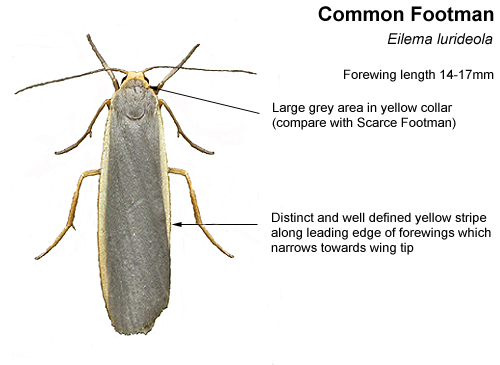 |
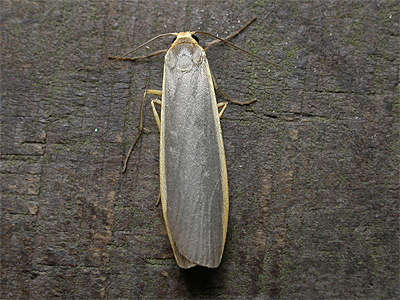 |
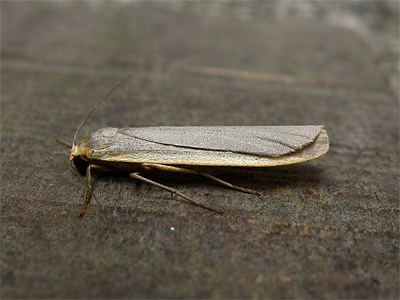 |
|
| 72.046 .... B&F 2047 .... Scarce Footman Eilema complana (Linnaeus,
1758) |
| Nottinghamshire
status and distribution: Scarce Footman has
increased enormously in recent years, yet is still a
Grade 3 moth in Nottinghamshire, despite it now being
extremely widespread across the county. Has proved to be very common at light at several Sherwood Forest sites in recent years, yet interestingly, it was never recorded once by a Rothamsted trap run every night there for five years between 1986 and 1990. Found in a range of habitats, especially heathland and woodland. Flight period: June to August, with most records coming in July. Identification features: The characteristic rolled up wings when at rest makes the Scarce Footman a distinctive moth, but when newly arrived at an MV light trap, some examples can hold their wings flat for a while, leading to confusion with Common Footman. |
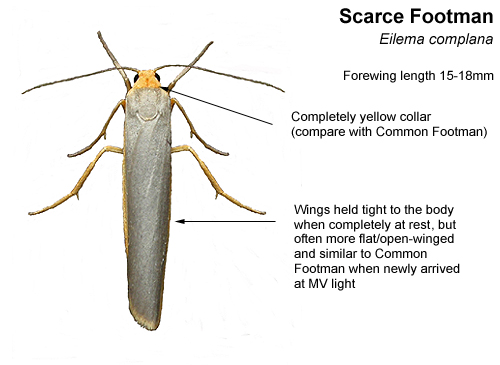 |
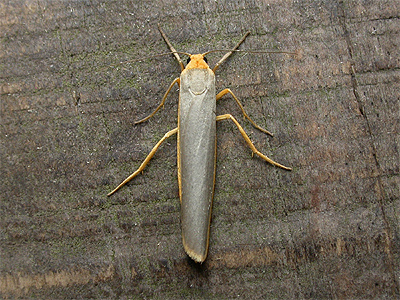 |
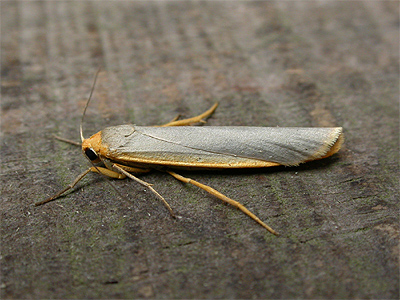 |
|
| 72.049 .... B&F 2043 .... Orange Footman Eilema sororcula (Hufnagel,
1766) |
| Nottinghamshire
status and distribution: Usually found in
mature, deciduous woodlands, Orange Footman is uncommon,
but has increased in recent years. Most records are from
the central north of Nottinghamshire. Flight period: Flies from late May to June. Identification features: The identification of Orange Footman should not really pose too much of a problem. Even the yellow forms of both Dingy Footman and Buff Footman are paler. Worn examples of Orange Footman can be recognised by the distinct straight edge to the basal half of the forewings (much straighter than that shown by Buff Footman) and the strongly curved edge towards the tip of the wing. This gives the wings of Orange Footman a more angular shape than all the other Nottinghamshire species. |
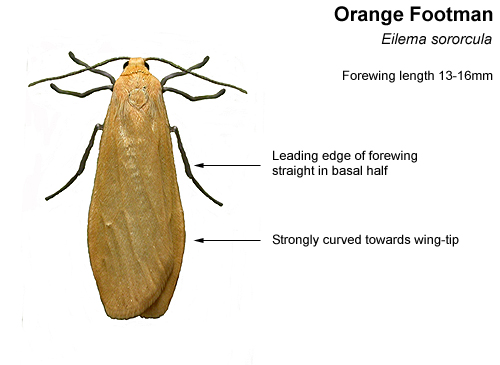 |
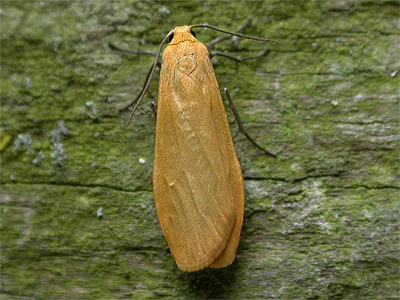 |
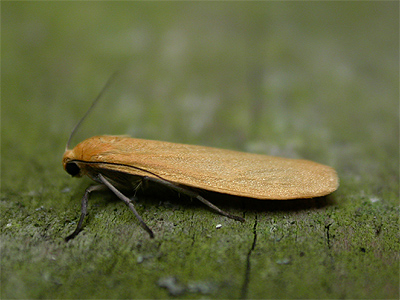 |
|